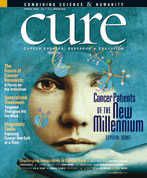Publication
Article
CURE
Blame the Bacteria
Author(s):
The 2005 Nobel Prize in Medicine was awarded to two scientists who discovered that the bacterium Helicobacter pylori is a risk factor for MALT lymphoma.
The 2005 Nobel Prize in Medicine was awarded to two scientists who discovered that the bacterium Helicobacter pylori is a risk factor for a rare type of non-Hodgkin’s lymphoma called mucosa-associated lymphoid tissue (MALT) lymphoma, a type of B-cell lymphoma that accounts for about 5 percent of all lymphoma cases.
Whereas most lymphomas originate in lymph nodes, MALT is commonly found in the stomach, but also can appear in the thyroid gland, lungs or eyes.
H. pylori lives in the mucosal lining of the stomach, safe from the stomach’s digestive juices. It also is protected by urease, an enzyme the bacteria create to counteract stomach acid. Although cells of the immune system travel to the stomach to fight off the bacteria, the unsuccessful attempt can produce too many lymphocytes, increasing the risk of lymphoma.
While H. pylori is found in about half of all people worldwide, it only causes problems in 10 to 15 percent of those infected. Between 80 to 90 percent of stomach ulcers and over 60 percent of all MALT cases are due to the bacterium. Many patients with gastric MALT lymphomas also have H. pylori gastritis, or inflammation of the stomach
lining.
A person’s genetic makeup may also make them more susceptible to H. pylori-related diseases, which include gastritis, peptic ulcers and possibly stomach cancer. While antacids may help stomach pain temporarily, they won’t kill the bacteria. Scientists are studying whether antibiotics can prevent or treat H. pylori-caused diseases, including MALT. Using the antibiotic clarithromycin with omeprazole, a proton pump inhibitor, can treat most cases of H. pylori-related MALT. In cases where clarithromycin and omeprazole do not produce a remission or the disease has spread, surgery and radiation therapy are other treatment options.






